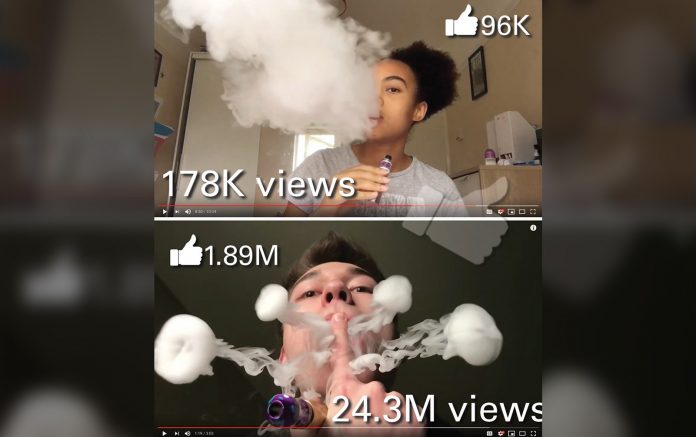Posted: February 12, 2020

As of early December 2019, the Centers for Disease Control and Prevention (CDC) have received reports from all 50 states, Puerto Rico, the U.S. Virgin Islands, and the District of Columbia comprising 2,291 individuals who were hospitalized for acute lung injury caused by vaping.1 Of these patients, many of whom are teenagers or young adults, 48 have died. Lisa Fucito, PhD, associate professor of Psychiatry and director of the Tobacco Treatment Service Smilow Cancer Hospital at Yale-New Haven, spoke with the IASLC Lung Cancer News about the recent advent of e-cigarette/vaping-associated lung injury (EVALI), as well as about how e-cigarette/vaping companies have learned much more quickly than healthcare providers how to influence substance habits of youth. Dr. Fucito’s current research includes a randomized clinical trial (RCT) of tobacco cessation tools for individuals undergoing lung cancer screening, implementation of a statewide tobacco treatment program for patients treated through the Yale Cancer Center care network, and an RCT of a novel mobile alcohol prevention program for young adults. She discusses sensitive approaches to communication between healthcare professionals and patients with lung cancer regarding e-cigarette use.
Q: Is e-cigarette/vaping use an epidemic among youth?
A: Well, it’s important to think about how we define an epidemic. Typically when we’ve thought about an epidemic, we think about a very rapid spread of an infectious disease to a large number of people. I think the rapid increase in e-cigarette use follows a pattern similar to an epidemic when solely looking at time. Between 2011 and 2015, e-cigarette use by U.S. middle and high school students increased by 900%. That’s an astronomical figure. Currently, the acute lung injuries, or EVALI, that are being seen across the country feel very much akin to an epidemic. Although reports of EVALI are slowing, there was an extremely rapid increase over the span of just a few months starting in June 2019, some of which resulted in the deaths of otherwise healthy adults, young adults, and teens.
Q: How do you explain such a large uptake of e-cigarette/vaping use by youth seen in such a short period of time?
A: There are a number of contributing factors, such as the ability to use very youth-friendly flavors (candy or fruit) with these devices. Most youth who begin using e-cigarettes report that they start with a flavored product and that the flavor itself was a key reason they tried the product.1
I mentioned previously that there was a steep rise in e-cigarette use between 2011 and 2015, but then there was actually a dip between 2015 and 2017. In 2017, however, a new nicotine-based derivative product (i.e., Juul) came onto the market. These products use a salt-solution–based form of nicotine that allows the user to reach peak nicotine levels that are similar to those achieved by combustible cigarettes. These newer products are pretty discreet to use; they are very small, look like a computer flash drive, and don’t produce as much vapor or smell. Teens have anecdotally reported that a lot of teachers did not even realize that these devices were being used in schools because they were that discreet. So in 2017, again, there was another sharp increase in usage, with e-cigarette/vaping increasing by 78% among U.S. high school students.
Throughout this entire time period, these products were promoted on social media platforms, like Instagram and Twitter, to influence youth behavior. E-cigarette manufacturers used attractive, young models to pitch their products on social media and hosted live events where free samples were made available to youth. So it was the combination of easy access, youth-friendly marketing practices, and flavors that really drove their uptake by so many.
Q: Does social-media marketing/content influence adults and youth in the same ways?
A: Young people tend to use different forms of social media than adults/older adults. E-cigarette/vaping advertising occurred more frequently on sites popular with young people: Instagram, YouTube, and Twitter versus Facebook. Young adult influencers were also paid thousands of dollars a month to vape and review devices on YouTube, a site frequented more by youth than adults. Thus, youth may experience greater exposure to e-cigarette/vaping marketing and content.
Youth may also be more vulnerable to misleading marketing/information than adults. Many vaping-related websites and social media sites, where young people tend to get their product-related information, do not report complete information about vaping such as the recent vaping-related injuries.
Q: If tobacco-related information is regulated in advertising and marketing, why are there no regulations around e-cigarette/vaping-related information?
A: Tobacco companies are no longer permitted to use the advertising tricks that they previously used, such as youth-friendly characters like Joe Camel, because they encourage young people to initiate smoking.
Some e-cigarette/vaping product manufacturers are in fact owned by the tobacco companies, and there has been some backlash regarding manufacturer advertising tactics. For example, Juul got into a lot of trouble for pitching products directly to youth on social media. However, even if Juul is no longer permitted to advertise directly on social media, the problem is not solved. Social-media influencers—individuals with thousands or millions of followers—can adopt a product and market that product through positive reviews or even just usage. Companies no longer have to invest in advertising campaigns for products. Currently, there is no way to regulate that kind of third-party marketing. Due to social media, I think we have entered a totally different landscape now in terms of advertising and how to regulate it.
Q: What is the current status regarding investigations of EVALI cases?
A: Following these cases, the CDC conducted extensive investigations in collaboration with the U.S. Food and Drug Administration (FDA) and state and local health officials. On December 20, 2019, the CDC concluded that vitamin E acetate, an additive in some THC-containing e-cigarettes, was closely associated with EVALI. Although vitamin E acetate appears to be associated with EVALI, the CDC cautioned that they are investigating other substances and product sources.
All of the individuals with EVALI have reported a history of using e-cigarettes or vaping products. THC, an active ingredient in marijuana, was present in the product samples that the CDC tested, and most of the sickened patients reported a history of vaping THC-containing products.
The other established element about these products, particularly those that contained THC, is that they were obtained off the street or from informal sources—illicit dealers and family or friends. In addition, products that people were able to modify are also suspected as contributory. Some vaping devices are closed systems that use complementary nicotine-containing pods. Other devices, however, have a more open system that allows for modifications.
The CDC website for EVALI has information for healthcare providers as to how to establish, document, and report toxic cases of EVALI to local/state health departments and the CDC.2 Statistics and information are updated every week.
Q: Knowing what we do about e-cigarettes, should they be used for cessation, or are they creating more addiction?
A: In our tobacco cessation program, we recommend that patients first use FDA-approved tools and counseling strategies. Even if they have tried these products in the past, we encourage them to try them again with the added benefit of additional, regular support from our program. We remind them that sometimes it takes several attempts before an individual can achieve long-term abstinence. However, if individuals have tried these other strategies with limited success and want to pursue the use of e-cigarettes, we try to support people and at least meet them where they are on their cessation journey.
A trial by Hajek et al.3 performed in the United Kingdom showed that e-cigarettes were more effective at helping smokers quit combustible cigarettes than nicotine replacement therapy (NRT) of patients’ choice, including use of combination NRT. All smokers were provided at least four weekly counseling sessions and randomly assigned to e-cigarettes or NRT for 3 months in this trial of 886 smokers attending smoking cessation services. Although cessation of combustible cigarettes was significantly better in the e-cigarette group, a less positive note was that for the smokers who achieved abstinence in the e-cigarette group, most (80%) continued using e-cigarettes at 1 year. Furthermore, approximately 40% of smokers assigned to e-cigarettes had dual use of combustible and e-cigarettes at 1 year. And so, although e-cigarettes may facilitate cessation of combustible cigarettes, they may be habit forming in and of themselves. We don’t know the potential long-term risks of using these products.
The CDC website has helpful recommendations for clinicians and provides key information about these products. Many individuals do not understand that these products contain nicotine. Many are using these products more often than they were using cigarettes, for example in their homes, because there are fewer restrictions on their use and the vapors emitted are less noticeable than cigarette smoke. We have had patients come through our service who were using a vaping device so often that their nicotine levels exceeded 2 or 3 packs a day. Paying attention to how compulsive a behavior can become for someone is important. Healthcare providers can engage these individuals in an open-ended conversation about how, when, and where they are using these products and how they feel when they cannot use it. The nicotine withdrawal that people experience when they cannot use these products can be pretty profound, so I think being able to empathically point that out can be very reassuring to patients. It is a helpful dialogue. ✦
References:
1. Landry RL, Groom AL, Vu TT, et al. The role of flavors in vaping initiation and satisfaction among U.S. adults. Addict Behav. 2019;99:106077.
2. Centers for Disease Control and Prevention. Smoking and Tobacco Use: Outbreak of Lung Injury Associated with the Use of E-Cigarette, or Vaping, Products. Available at: https://www.cdc.gov/tobacco/basic_information/e-cigarettes/severe-lung-disease.html#what-is-new. Accessed December 10, 2019.
3. Hajek P, Phillips-Waller A, Przulj D, et al. A Randomized Trial of E-Cigarettes versus Nicotine-Replacement Therapy. N Engl J Med. 2019;380(7):629-637.











